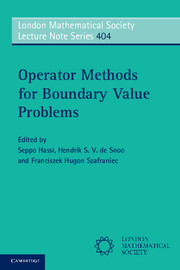Book contents
- Frontmatter
- Contents
- List of contributors
- Preface
- 1 John Williams Calkin: a short biography
- 2 On Calkin's abstract symmetric boundary conditions
- 3 Boundary triplets and maximal accretive extensions of sectorial operators
- 4 Boundary control state/signal systems and boundary triplets
- 5 Passive state/signal systems and conservative boundary relations
- 6 Elliptic operators, Dirichlet-to-Neumann maps and quasi boundary triples
- 7 Boundary triplets and Weyl functions. Recent developments
- 8 Extension theory for elliptic partial differential operators with pseudodifferential methods
- 9 Dirac structures and boundary relations
- 10 Naĭmark dilations and Naĭmark extensions in favour of moment problems
- References
6 - Elliptic operators, Dirichlet-to-Neumann maps and quasi boundary triples
Published online by Cambridge University Press: 05 November 2012
- Frontmatter
- Contents
- List of contributors
- Preface
- 1 John Williams Calkin: a short biography
- 2 On Calkin's abstract symmetric boundary conditions
- 3 Boundary triplets and maximal accretive extensions of sectorial operators
- 4 Boundary control state/signal systems and boundary triplets
- 5 Passive state/signal systems and conservative boundary relations
- 6 Elliptic operators, Dirichlet-to-Neumann maps and quasi boundary triples
- 7 Boundary triplets and Weyl functions. Recent developments
- 8 Extension theory for elliptic partial differential operators with pseudodifferential methods
- 9 Dirac structures and boundary relations
- 10 Naĭmark dilations and Naĭmark extensions in favour of moment problems
- References
Summary
Abstract The notion of quasi boundary triples and their Weyl functions is reviewed and applied to self-adjointness and spectral problems for a class of elliptic, formally symmetric, second order partial differential expressions with variable coefficients on bounded domains.
Introduction
Boundary triples and associated Weyl functions are a powerful and ef- fficient tool to parameterize the self-adjoint extensions of a symmetric operator and to describe their spectral properties. There are numerous papers applying boundary triple techniques to spectral problems for various types of ordinary differential operators in Hilbert spaces; see, e.g. [Behrndt and Langer, 2010; Behrndt, Malamud and Neidhardt, 2008; Behrndt and Trunk, 2007; Brasche, Malamud and Neidhardt, 2002; Brüning, Geyler and Pankrashkin, 2008; Derkach, Hassi and de Snoo, 2003; Gorbachuk and Gorbachuk, 1991; Derkach and Malamud, 1995; Karabash, Kostenko and Malamud, 2009; Kostenko and Malamud, 2010; Posilicano, 2008] and the references therein.
The abstract notion of boundary triples and Weyl functions is strongly inspired by Sturm-Liouville operators on a half-line and their Titchmarsh -Weyl coefficients. To make this more precise, let us consider the ordinary differential expression l = −D2 + q on the positive half-line ℝ+ = (0, ∞), where D denotes the derivative, and suppose that q is a real-valued L∞-function. The maximal operator associated with l in L2(ℝ+) is defined on the Sobolev space H2(ℝ+) and turns out to be the adjoint of the minimal operator S f = l(f), dom S =, where is the subspace of H2(ℝ+) consisting of functions f that satisfy the boundary conditions f(0) = f′(0) = 0.
- Type
- Chapter
- Information
- Operator Methods for Boundary Value Problems , pp. 121 - 160Publisher: Cambridge University PressPrint publication year: 2012
References
- 13
- Cited by



